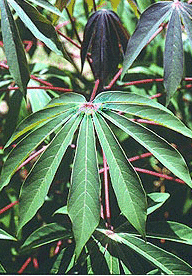


IMPORTANT: The information provided is for information only. The medical claims or advice are not endorsed. Never take any medicines without first consulting a qualified practitioner.

Cassava is a food staple for over 500 million people, and was eaten by the original inhabitants of the islands, the Taino.
In Europe it's probably better known as tapioca – Sloane called it tipioca. It provides cassava meal, flour and is used in soups, puddings and many other foods.
Eating raw cassava tubers can kill. It contains a cyanide, which is luckily destroyed by cooking. The Taino apparently tipped their arrows with the poison, and are said to have eaten raw cassava rather than be caught and tortured by the Spanish invaders.

Today, selective plant breeding has reduced the risk, but cassava must still always be cooked. The leaves are safe to eat and are a popular vegetable.
Traditional herbalists recommend the grated tuber as an excellent poultice for sores, also a paste of cassava flour added to pounded tobacco leaves.
The tubers can remain in the ground for up to three years without going bad, as they have a tough outer coat, and the cyanide in their hard white flesh protects them from insect attack. So they are a very important food reserve against famine.
Cassava starch has a pleasant taste and smell and makes a good natural adhesive, so is ideal as a gum, for stamps and envelopes. However, this use has declined since the 1950s.
Fermenting cassava produces a crude alcohol that smells disgusting. It is used in industry, in making cosmetics, solvents and medicinal products.